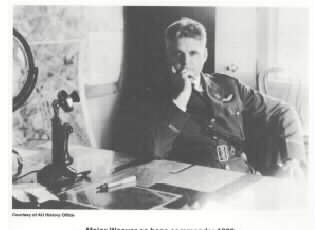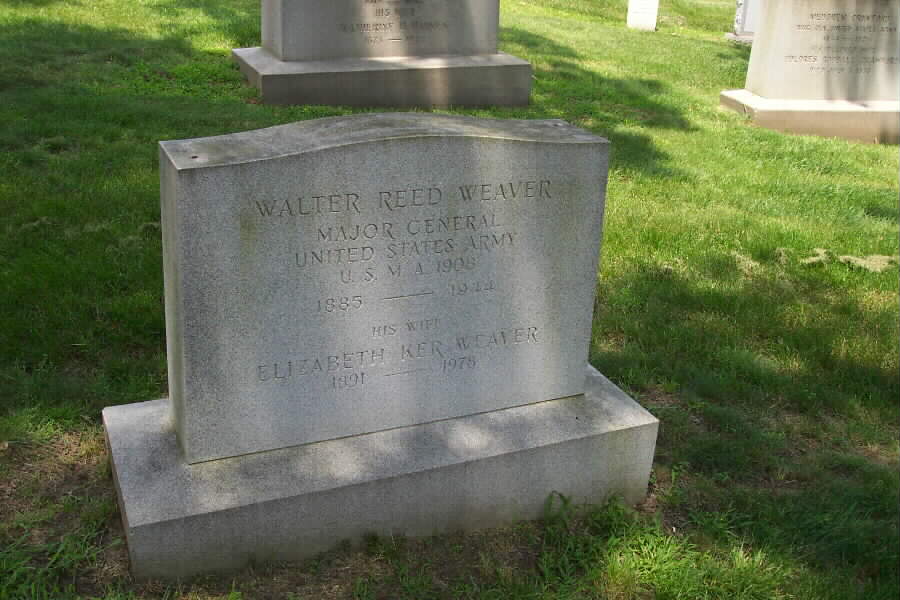WALTER REED WEAVER
23 February 1885-27 October 1944. Born in Charleston while his father was teaching at The Citadel, 1883-1886. He later became a Major General in the Army Air Corps. From December 1941 to March 1942, he was the acting head of the Air Corps while General Hap Arnold was in Europe.
Courtesy of Maxwell Air Force Base Office of History:
Walter R. Weaver
Walter Reed Weaver (1885-1944) was born in Charleston, South Carolina, where his father, Major General E. M. Weaver, served as commandant of The Citadel. The young Weaver, however, attended Virginia Military Institute (VMI) where George C. Marshall was his first Captain. After three years at VMI, Weaver entered West Point, graduating as a lieutenant of infantry in 1908.
He did not serve as an infantry captain in France in World War I as he had volunteered to do. Rather, he was transferred to the Signal Corps to command the flying cadets at Wright Field, Ohio. Anointed an aviation expert, Major Weaver earned some notoriety by opening an aviation mechanics’ school in Saint Paul, Minnesota, within only a matter of days of taking command. After World War I, he earned his pilot’s wings at March Field, California, and completed various other training and education courses at such institutions as Harvard University’s School of Business Administration.
From 1927 to 1931, Major Weaver served as commanding officer of Maxwell Field. During his tenure, Maxwell’s golden age of construction began. While he was base commander, the Southeast was hard hit by floods in March 1929. Alabama was worst affected by the Great Flood of 1929. The record flood waters isolated scores of towns as they swept away telephone and telegraph lines, roads, and rail lines; thousands of people were marooned without food or shelter. Observation flights from Maxwell gathered information for civil and military authorities. Douglas C-l transports flew relief flights from Maxwell, air dropping-without para- chutes-needed supplies, including copies of the Montgomery Advertiser, which gave instructions on how to communicate with pilots. In the five-day relief effort, 40 planes flew 281 missions or more than 600 hours. Major Weaver’s efforts were praised by authorities in Washington, but more so by thou- sands in southeast Alabama.
During 1939-40, Colonel Weaver served as Commandant of the Air Corps Tactical School. From 1940 to 1941, Brigadier General Weaver commanded the Southeast Air Corps Training Center headquartered at Maxwell. His greatest service to the nation was as commander of the Army Air Forces Technical Training Command from 1942 to 1943. In this position, Major General Weaver organized and commanded more than a hundred training stations that transformed a million civilians into airmen-the technicians who kept the planes flying. As he had been throughout his Army career, General Weaver was innovative and tireless, and made things happen. He opened his first training school less than one week after assuming command. Because he under- stood politics, as welt as leadership and aviation, he moved his headquarters out of Washington. Maintaining that since “the good Lord can run the whole universe on Ten Commandments,” he cut the number of regulations for his command to eight.
General Weaver no longer has a monument at Maxwell. His old marble marker was removed several years ago; it was replaced by a monument to the Reserve Officer Training Corps and Second Lieutenant William C. Maxwell. However, General Weaver needs no such monument of brick, stone, or bronze-the World War II record of the Army Air Forces maintenance personnel serves as his monument.
Walter Reed Wever as Major, Air Corps
United States Army Photo
WEAVER, WALTER R
- MAJ GEN U S ARMY RET S C
- DATE OF BIRTH: 02/23/1885
- DATE OF DEATH: 10/27/1944
- BURIED AT: SECTION SOUTH SITE 1908
ARLINGTON NATIONAL CEMETERY
Michael Robert Patterson was born in Arlington and is the son of a former officer of the US Army. So it was no wonder that sooner or later his interests drew him to American history and especially to American military history. Many of his articles can be found on renowned portals like the New York Times, Washingtonpost or Wikipedia.
Reviewed by: Michael Howard


